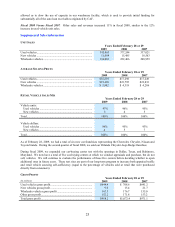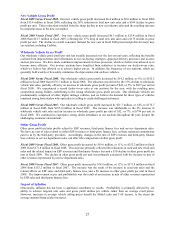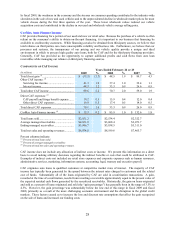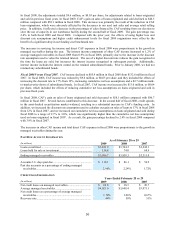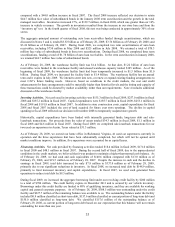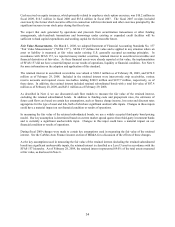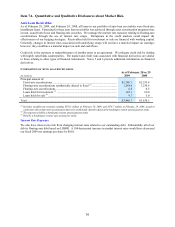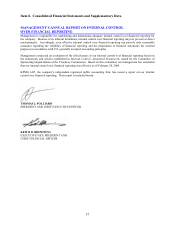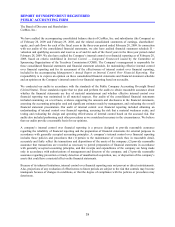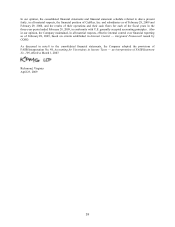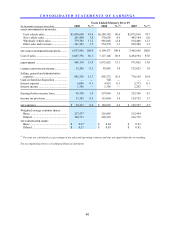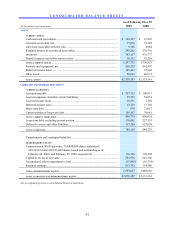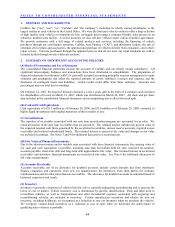CarMax 2009 Annual Report Download - page 40
Download and view the complete annual report
Please find page 40 of the 2009 CarMax annual report below. You can navigate through the pages in the report by either clicking on the pages listed below, or by using the keyword search tool below to find specific information within the annual report.34
Cash received on equity issuances, which primarily related to employee stock option exercises, was $10.2 million in
fiscal 2009, $14.7 million in fiscal 2008 and $35.4 million in fiscal 2007. The fiscal 2007 receipts included
exercises by the former chief executive officer in connection with his retirement and other exercises prompted by the
significant increase in our stock price during that fiscal year.
We expect that cash generated by operations and proceeds from securitization transactions or other funding
arrangements, sale-leaseback transactions and borrowings under existing or expanded credit facilities will be
sufficient to fund capital expenditures and working capital for the foreseeable future.
Fair Value Measurements. On March 1, 2008, we adopted Statement of Financial Accounting Standards No. 157
“Fair Value Measurements” (“SFAS 157”). SFAS 157 defines fair value and is applied in any situation where an
asset or liability is measured at fair value under existing U.S. generally accepted accounting principles. In
accordance with SFAS 157, we reported money market securities, retained interest in securitized receivables and
financial derivatives at fair value. As these financial assets were already reported at fair value, the implementation
of SFAS 157 did not have a material impact on our results of operations, liquidity or financial condition. See Note 6
for more information on the adoption and application of this standard.
The retained interest in securitized receivables was valued at $348.3 million as of February 28, 2009, and $270.8
million as of February 29, 2008. Included in the retained interest were interest-only strip receivables, various
reserve accounts and required excess receivables totaling $260.9 million and $227.7 million, respectively, as of
these dates. In addition, the retained interest included retained subordinated bonds with a total fair value of $87.4
million as of February 28, 2009, and $43.1 million as of February 29, 2008.
As described in Note 4, we use discounted cash flow models to measure the fair value of the retained interest,
excluding the retained subordinated bonds. In addition to funding costs and prepayment rates, the estimates of
future cash flows are based on certain key assumptions, such as finance charge income, loss rates and discount rates
appropriate for the type of asset and risk, both of which are significant unobservable inputs. Changes in these inputs
could have a material impact on our financial condition or results of operations.
In measuring the fair value of the retained subordinated bonds, we use a widely accepted third-party bond pricing
model. Our key assumption is determined based on current market spread quotes from third-party investment banks
and is currently a significant unobservable input. Changes in this input could have a material impact on our
financial condition or results of operations.
During fiscal 2009 changes were made to certain key assumptions used in measuring the fair value of the retained
interest. See the CarMax Auto Finance Income section of MD&A for a discussion of the effects of these changes.
As the key assumptions used in measuring the fair value of the retained interest (including the retained subordinated
bonds) are significant unobservable inputs, the retained interest is classified as a Level 3 asset in accordance with the
SFAS 157 hierarchy. As of February 28, 2009, the retained interest represented 69.0% of the total assets measured
at fair value, as disclosed in Note 6.



